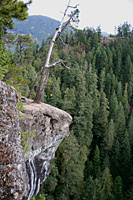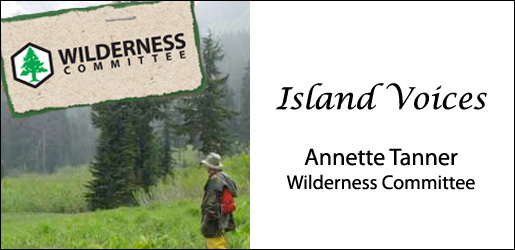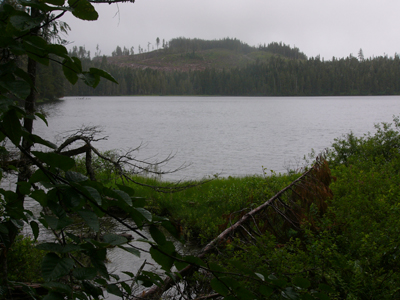Annette Tanner — September 2008
Current Article ∙ Archive ∙ Back to Island Voices
Slideshow to Reveal Logging Threats in Cathedral Grove Headwaters
Reports of logging flagging tape in the Cathedral Grove headwaters have now been confirmed by the Wilderness Committee’s Mid Island chapter after a recent tour to Labour Day Lake. A spectacular slideshow of the area and a public meeting to address concerns about logging the oldgrowth forest surrounding Cathedral Grove’s Labour Day Lake headwaters will take place Thursday, September 11 at the Qualicum Beach Civic Centre.
Labour Day Lake is surrounded by some of the last oldgrowth forest that has not yet been logged in Cathedral Grove. The forested Lake and its waterfalls create the pristine and abundant water supply for the entire Cathedral Grove Watershed, which is also an officially designated drinking watershed, supplying drinking water to the Town of Qualicum Beach and the community of Dashwood.
The quantity and quality of our drinking water for the fast growing communities need to be protected for future planned growth and not be squandered for private profit. A good business plan for our Provincial Government would be to protect this important public interest by protecting the headwaters and all remaining oldgrowth in the world-famous Cathedral Grove watershed.
Early settlers and communities have been working since the mid 1800’s to protect Cathedral Grove. Now is the time to protect what is left.
The Slideshow begins at 7:00 pm
at the Qualicum Beach Civic Centre, Thursday, September 18.
Everyone is welcome. Admission by donation.
There wil be an opportunity to sign-up for tours to the area.
Information: 250 752-6585
Below, are photos of our 4th annual BC Park Lovers Day in August when we hiked up to Labour Day Lake.
On BC Park Lovers day, signatures are gathered and information distributed throughout the province, about our BC Park system that has suffered from under-funding and understaffing. Our Mid Island Chapter concentrates mostly on Rathtrevor Provincial Park, Strathcona and Cathedral Grove, where it is common to end up with over 500 signatures on a petition within 3 hours spent in the world famous park.
The enthusiasm and interest from the many international visitors to Cathedral Grove made us decide that this year on BC Parks Lovers day, we would hike up to the headwaters of the Grove. Throughout the province, BC Park Lovers Day focuses on the BC park budget which was slashed by almost 30 percent since 2001, and the fact that the money hasn’t been reinstated. As a result, our park budget is below Alberta’s and park staffing is barely half of what it was 10 years ago. On the east side of Vancouver Island, however, we must face an even greater problem – WE JUST DON”T HAVE ENOUGH PARKS to meet the recreation demands of the local population, visitors or the habitat requirements for sustaining wildlife. !
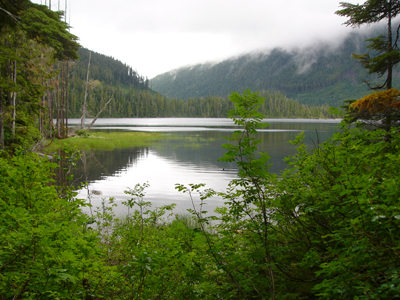
The rest of the province is almost 95 percent Crown Land while the east side of Vancouver Island is approximately 95 percent private land (see map www.cathedralgrovecanyon.com). Roughly 12 percent of the province is designated parkland, while only 2 percent of Vancouver Island’s east side is protected as parks.
The Wilderness Committee is working to protect all of Cathedral Grove and we hope that Thursday’s slideshow of the still pristine Labour Day Lake will inspire all of us to work harder in asking the province to protect what is left.
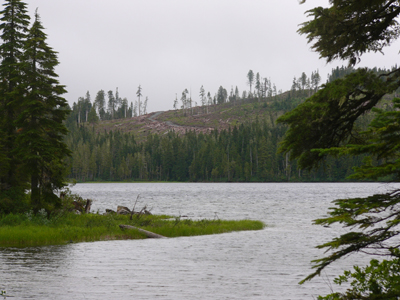
Pertinent Facts on BC Provincial Parks
In 2001 the provincial government cut the budget for BC Parks by approximately 30 percent – as of 2008 this money has not been recouped.
Much of the government’s rationale for cutbacks in parks is premised on the erroneous notion that parks don’t pay for themselves. However, a 2001 government report shows that for every $1 the government spends on protected areas in BC, over $10 are returned to local economies through visitor expenditures.
BC has over 856 parks and protected areas (more if you take into account conservancies) yet there are just 10 full time permanent park rangers in BC in 2001 there were 26 full time permanent rangers. In the summer this number goes up with the hiring of approximately 120 seasonal part-time park rangers. In the 2005 throne speech the BC Government promised to hire up to 50 park rangers this has not materialized. In 2001 there were 180 park rangers hired (seasonal and full-time in 2007 the number of seasonal and full-time rangers was just 134 – approximately 1 ranger for every 6 provincial parks).
In regards to BC Park staff in 1996 there were 363 full-time equivalent staff. In 2007 that number had dwindled to just under 200 positions although the amount of protected area had almost doubled.
BC Parks Operational Budget The operational budget for BC Parks is approximately $35 million – just over $2.50 per hectare. This per hectare budget puts us below nearly every other jurisdiction in Western North America including Alberta, Saskatchewan Manitoba, Washington, Oregon and our national park system. We are calling for the operational budget for BC Parks to be at least doubled. BC Parks contribute over $170 million to the provincial tax base. According to the government’s own study for every $1 invested in the provincial park system almost $10 is generated in visitor expenditures to nearby communities.
Visitors Visits to BC Parks peaked in 1998 at about 25 million visits. It has since slumped to about 18 million visits per year a dramatic decline not witnessed in neighbouring jurisdictions. Parking meters drove away nearly 1,000,000 visitors when they were first introduced.
Other impacts on parks include degrading trail systems and lack of government-funded interpretive programs although the BC government has started to kick in a few dollars for interpretive programs it is far below the standard that was in place 10 years ago. (A partnership with Park Facility Operators (PFOs), the Federation of BC Naturalists (FBCN) and BC Parks to provide park interpretation programs in several BC Parks. Fifteen Conservation Corps members will provide interpretation services in provincial parks. Corps members will be augmented through application for Human Resources Canada (RDC) and through PFO staff.)
Some tidbits: Staffing levels at provincial parks have been cut so dramatically that employees are no longer able to effectively protect BC’s parks. In Manning Park, 1 full time park ranger and 3 seasonal staff oversee 91,000 hectares of parkland and 858,000 annual visitors. Mount Robson provincial park employs only 1.8 full-time and 3 seasonal staff to manage 300,000 hectares. (Information from 2005) By contrast, Alberta’s 260,000 hectare Kananaskis Country park system employs 75 full-time and 19 seasonal staff. Likewise, the federally funded Glacier and Mount Revelstoke national parks in BC employ 37 full time and 39 seasonal staff to manage 160,900 hectares of parkland.
For more information please contact Annette Tanner at –
Tel: (250) 752-6595. Fax: (250) 752-7085. E-mail wcwcqb@shaw.ca
